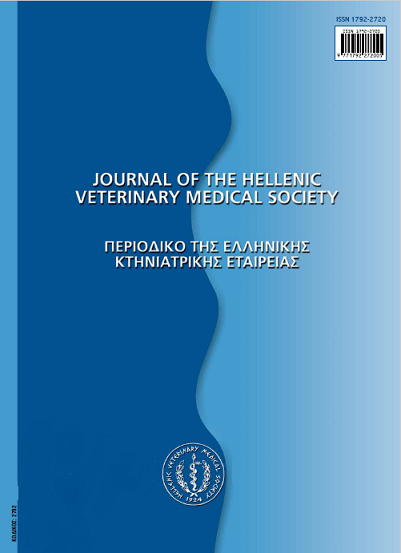Effect of increased dietary fiber on hoof lesions of loose housed sows
Abstract
Loose dry sow housing became mandatory in the European Union from January 2013 onwards. One of the major causes of injuries to sows’ hooves and associated lameness is fighting on concrete/slatted flooring at grouping. Previous studies observed that in sows submitted to feed restriction, feed supplemented with dietary fiber reduced the time spent in the standing position and increased the time spent in the lying position. Therefore, we investigated the effect of increased levels of dietary fiber (7.2-7.5% crude fiber/kg dry matter) on the severity of hoof lesions of group housed sows in three Greek swine herds. The feet of 596 sows were initially examined for lesions upon their entry to the lactation facilities. Lesions scored included hoof hyperkeratinization, erosions or cracks and toe and dew claws overgrowths. When exiting the farrowing facilities they were offered recipes with increased dietary fiber throughout one or two subsequent gestations. Thirty-eight percent were re-examined for feet lesions during the first and sixty-two percent during the second lactation after initial examination. The proportion of sows with at least one lesion on any foot, at first scoring, was more than 95% in all herds. The most frequently and severely affected sites were the heel and the elongated toes and dew claws. The increased dietary fiber had no effect on lesion severity on any of the hoof sites considered.
Article Details
- Come citare
-
SKAMPARDONIS (Β. ΣΚΑΜΠΑΡΔΩΝΗΣ) V., LISGARA (Μ. ΛΙΣΓΑΡΑ) M., TZIKA (E. TZHKA), E. D., & LEONTIDES (Λ. ΛΕΟΝΤΙΔΗΣ) L. (2018). Effect of increased dietary fiber on hoof lesions of loose housed sows. Journal of the Hellenic Veterinary Medical Society, 67(1), 39–46. https://doi.org/10.12681/jhvms.15622
- Fascicolo
- V. 67 N. 1 (2016)
- Sezione
- Research Articles

Questo lavoro è fornito con la licenza Creative Commons Attribuzione - Non commerciale 4.0 Internazionale.
Authors who publish with this journal agree to the following terms:
· Authors retain copyright and grant the journal right of first publication with the work simultaneously licensed under a Creative Commons Attribution Non-Commercial License that allows others to share the work with an acknowledgement of the work's authorship and initial publication in this journal.
· Authors are able to enter into separate, additional contractual arrangements for the non-exclusive distribution of the journal's published version of the work (e.g. post it to an institutional repository or publish it in a book), with an acknowledgement of its initial publication in this journal.
· Authors are permitted and encouraged to post their work online (preferably in institutional repositories or on their website) prior to and during the submission process, as it can lead to productive exchanges, as well as earlier and greater citation of published work.





